Related Research Articles

A film crew is a group of people, hired by a production company, for the purpose of producing a film or motion picture. The crew is distinguished from the cast, as the cast are understood to be the actors who appear in front of the camera or provide voices for characters in the film. The crew is also separate from the producers, as the producers are the ones who own a portion of either the film studio or the film's intellectual property rights. A film crew is divided into different departments, each of which specializes in a specific aspect of the production. Film crew positions have evolved over the years, spurred by technological change, but many traditional jobs date from the early 20th century and are common across jurisdictions and filmmaking cultures.
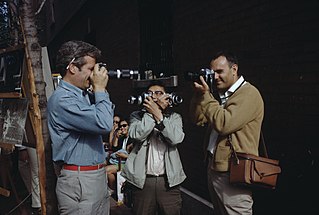
Photography is the art, application, and practice of creating images by recording light, either electronically by means of an image sensor, or chemically by means of a light-sensitive material such as photographic film. It is employed in many fields of science, manufacturing, and business, as well as its more direct uses for art, film and video production, recreational purposes, hobby, and mass communication.

A camera obscura is a darkened room with a small hole or lens at one side through which an image is projected onto a wall or table opposite the hole. The image of lensless camera obscuras is also referred to as "pinhole image".

A view camera is a large-format camera in which the lens forms an inverted image on a ground-glass screen directly at the film plane. The image is viewed and then the glass screen is replaced with the film, and thus the film is exposed to exactly the same image as was seen on the screen.
In photography and cinematography, a normal lens is a lens that reproduces a field of view that appears "natural" to a human observer. In contrast, depth compression and expansion with shorter or longer focal lengths introduces noticeable, and sometimes disturbing, distortion.

Forced perspective is a technique that employs optical illusion to make an object appear farther away, closer, larger or smaller than it actually is. It manipulates human visual perception through the use of scaled objects and the correlation between them and the vantage point of the spectator or camera. It has uses in photography, filmmaking and architecture.
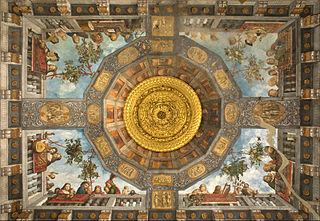
Trompe-l'œil is an artistic term for the highly realistic optical illusion of three-dimensional space and objects on a two-dimensional surface. Trompe l'œil, which is most often associated with painting, tricks the viewer into perceiving painted objects or spaces as real. Forced perspective is a related illusion in architecture.

A vanishing point is a point on the image plane of a perspective rendering where the two-dimensional perspective projections of mutually parallel lines in three-dimensional space appear to converge. When the set of parallel lines is perpendicular to a picture plane, the construction is known as one-point perspective, and their vanishing point corresponds to the oculus, or "eye point", from which the image should be viewed for correct perspective geometry. Traditional linear drawings use objects with one to three sets of parallels, defining one to three vanishing points.

Principal photography is the phase of producing a film or television show in which the bulk of shooting takes place, as distinct from the phases of pre-production and post-production.
QuickTime VR is an image file format developed by Apple Inc. for QuickTime, and discontinued along with QuickTime 7. It allows the creation and viewing of VR photography, photographically captured panoramas, and the viewing of objects photographed from multiple angles. It functions as plugins for the QuickTime Player and for the QuickTime Web browser plugin.
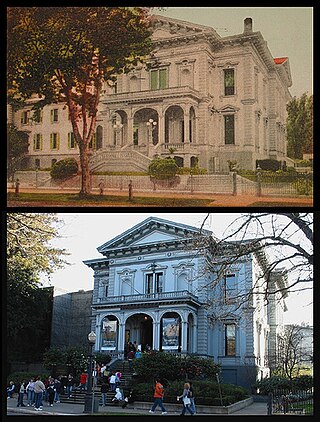
Rephotography is the act of repeat photography of the same site, with a time lag between the two images; a diachronic, "then and now" view of a particular area. Some are casual, usually taken from the same view point but without regard to season, lens coverage or framing. Some are very precise and involve a careful study of the original image.

A tableau vivant, French for 'living picture', is a static scene containing one or more actors or models. They are stationary and silent, usually in costume, carefully posed, with props and/or scenery, and may be theatrically lit. It thus combines aspects of theatre and the visual arts.
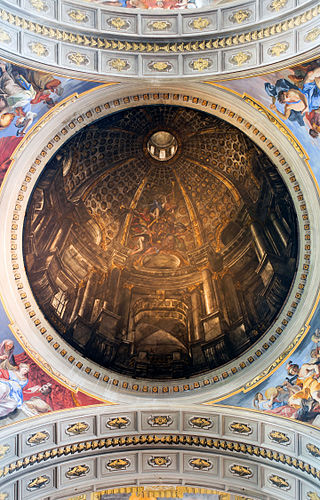
Illusionistic ceiling painting, which includes the techniques of perspective di sotto in sù and quadratura, is the tradition in Renaissance, Baroque and Rococo art in which trompe-l'œil, perspective tools such as foreshortening, and other spatial effects are used to create the illusion of three-dimensional space on an otherwise two-dimensional or mostly flat ceiling surface above the viewer. It is frequently used to create the illusion of an open sky, such as with the oculus in Andrea Mantegna's Camera degli Sposi, or the illusion of an architectural space such as the cupola, one of Andrea Pozzo's frescoes in Sant'Ignazio, Rome. Illusionistic ceiling painting belongs to the general class of illusionism in art, designed to create accurate representations of reality.

A bird's-eye view is an elevated view of an object or location from a very steep viewing angle, creating a perspective as if the observer were a bird in flight looking downwards. Bird's-eye views can be an aerial photograph, but also a drawing, and are often used in the making of blueprints, floor plans and maps.
The camera angle marks the specific location at which the movie camera or video camera is placed to take a shot. A scene may be shot from several camera angles simultaneously. This will give a different experience and sometimes emotion. The different camera angles will have different effects on the viewer and how they perceive the scene that is shot. There are a few different routes that a camera operator could take to achieve this effect.
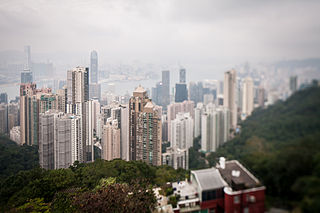
Tilt–shift photography is the use of camera movements that change the orientation or position of the lens with respect to the film or image sensor on cameras.

Barbara Probst is a contemporary artist whose photographic work consists of multiple images of a single scene, shot simultaneously with several cameras via a radio-controlled system. Using a mix of color and black-and-white film, she poses her subjects, positioning each lens at a different angle, and then triggers the cameras’ shutters all at once, creating tableaux of two or more individually framed images. Although the pictures are of the same subject and are taken at the same instant, they provide a range of perspectives. She lives and works in both New York City and Munich. She relocated to New York City in 1997.
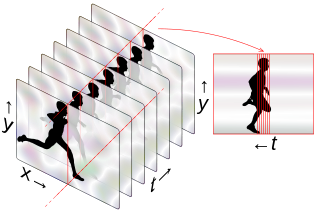
Strip photography, or slit photography, is a photographic technique of capturing a two-dimensional image as a sequence of one-dimensional images over time, in contrast to a normal photo which is a single two-dimensional image at one point in time. A moving scene is recorded, over a period of time, using a camera that observes a narrow strip rather than the full field. If the subject is moving through this observed strip at constant speed, they will appear in the finished photo as a visible object. Stationary objects, like the background, will be the same the whole way across the photo and appear as stripes along the time axis; see examples on this page.
Oculus, may refer to the following

A virtual reality headset is a head-mounted device that provides virtual reality for the wearer. VR headsets are widely used with VR video games but they are also used in other applications, including simulators and trainers. VR headsets typically include a stereoscopic display, stereo sound, and sensors like accelerometers and gyroscopes for tracking the pose of the user's head to match the orientation of the virtual camera with the user's eye positions in the real world.
References
- ↑ Michael LaForte Perspective Terms and Definitions (archived) from Studio LaForte
- ↑ Kirsti Andersen (2007) Geometry of an Art, p. xxix, Springer, ISBN 0-387-25961-9